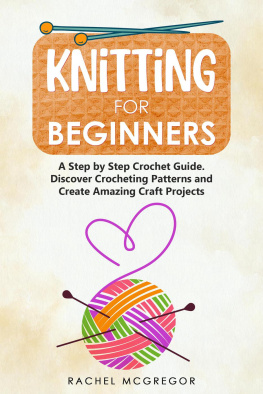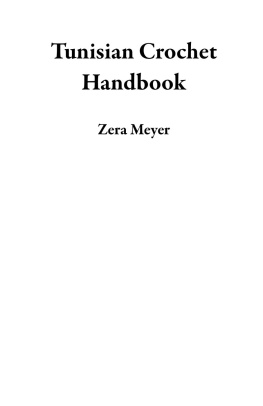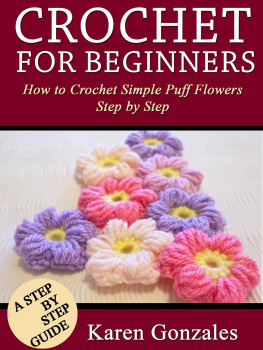Crochet for Beginners
The Ultimate Guide to Crocheting. Discover Needlework, Create Crochet Patterns and Stitches Follow Useful Techniques and Illustrations
By
Charlotte White
Copyright 2020 by (Charlotte White) - All rights reserved.
This document is geared towards providing exact and reliable information in regards to the topic and issue covered. The publication is sold with the idea that the publisher is not required to render accounting, officially permitted, or otherwise, qualified services. If advice is necessary, legal or professional, a practiced individual in the profession should be ordered.
- From a Declaration of Principles which was accepted and approved equally by a Committee of the American Bar Association and a Committee of Publishers and Associations.
In no way is it legal to reproduce, duplicate, or transmit any part of this document in either electronic means or in printed format. Recording of this publication is strictly prohibited and any storage of this document is not allowed unless with written permission from the publisher. All rights reserved. The information provided herein is stated to be truthful and consistent, in that any liability, in terms of inattention or otherwise, by any usage or abuse of any policies, processes, or directions contained within is the solitary and utter responsibility of the recipient reader. Under no circumstances will any legal responsibility or blame be held against the publisher for any reparation, damages, or monetary loss due to the information herein, either directly or indirectly.
Respective authors own all copyrights not held by the publisher.
The information herein is offered for informational purposes solely, and is universal as so. The presentation of the information is without contract or any type of guarantee assurance.
The trademarks that are used are without any consent, and the publication of the trademark is without permission or backing by the trademark owner. All trademarks and brands within this book are for clarifying purposes only and are the owned by the owners themselves, not affiliated with this document.
Table of Contents
C rochet is an art form that is generations old and derives from the French word crochet that means a hook. Crochet, is an entertaining and calming activity and is very easy to learn.You can make gorgeous clothing and home decoration items such as hats, tops, scarves, ponchos, tablecloths, bedspreads and doilies as well as cute pieces only for kids using this trendy needle craft.
Crochet requires only 2 basic supplies-a crochet hook and a thread or yarn. Most crochet stitches are a sequence of yarn overs or thread wraps around a hook, once you learn the single crochet stitch, others come effortlessly! Although most designs begin with a slip stitch and a sequence of loops called chains, without a conventional chain, you can still learn to build foundations. Crochet designs are done in rows where you crochet back and forth, every row above the previous row, or in circles where you work around and around a middle ring of loops, forming a geometric figure such as a circle, hex or rectangle. A motif is just a piece of geometry that you make as many times as you need, after which you sew it all together to shape your final product.
In the sixteenth century, nuns trained their graduates the skill, and it became an acknowledged achievement of a woman of high birth. Crochet was deemed suitable only for wealthy people, with the more unfortunate people using knitting pieces.
In the early 1800s, fabrics made from lace were much more costly than the crochet products. In Europe, crochet seems to have grown in two very separate milieus independently. Crochet tutorials were written in the 1840s, and then crochet became increasingly popular. Before this point crochet was passed down with in the families. From one generation handing over the skill of crocheting to the next. The early 19th-century version of crochet, popularly known as shepherd's knitting, was created using wooden hooks crafted from bones or old spoons. Around the same time, another version of the art evolved out of a much older style of needlework called tambourine. Perhaps originating in India, Turkey, and Persia, the tambourine was carried out using a very tiny hooked needle embedded in cloth spread over a work-frame. The intermediate phase was to discard the fabric and carry out the looped chain stitch "in the air," as it was named in France.
Many societies choose crochet items to define their social class, which simply shows that they can afford crochet products and other things crafted from lace. The crocheting art needs only less costly materials and equipment, which are usually threads and yarns that can be purchase from local stores.
Most people believe that knitting and crocheting art has been originated in countries such as Saudi Arabia, Brazil, and China. People have come up to this conclusion because of the cultural background of clothes worn by the citizens residing in those countries. Some experts often claim that the crocheting technique was more critical in bending the forefinger than in making crochet and knitted products.
Throughout the nineteenth century, this particular type of crochet evolved in Europe and the United States, mainly as a female activity. In women's magazines of this time, various crochet designs appear, ranging from traditional clothing applications including blouses, bonnets, collars, scarves, babywear, and slippers to such incredible designs as birdcage coverings. The art museum collections include a wealth of crocheted bags and purses from the latter half of the 19th century. Some of the absolute best artifacts are the bags of miser, crafted with fine colored silks and small glass or metal beads. At both sides, these bags were curved or squared at one end and rounded at the other and had a tiny hole by which coins would pass.
In the mid-19th century, Tunisian crochet designs started to appear. This type of crochet was a fusion knitting/crochet technique capable of making a robust and reliable garment structure, such as shawls, waistcoats, and dresses for kids. The method was once called the Afghan stitch and is still being taught in southeastern Europe, suggesting other regional paths for further study into the roots and distribution of crochet.
Although crochet was a leisure class pursuit, it was also a cottage industry, offering economic relief from the effects of industrialization and migration in rural areas of the country. The most notable example of this business was the Irish crochet that created some prime examples of crocheted garments. This delicate lace-like type (also known as guipure lace) probably evolved out of an economic necessity to find a less costly alternative to bobbin lace and needlepoint lace. Several floral-like patterns were precisely crocheted over thicker strings on cotton, and combined with fine mesh to create a lace-like design often of immense sophistication and delicacy. Irish crochet offered a source of food and shelter for dozens of Irish farmer families during most of the potato famine (1845-1850). As with many new industries of this time, entrepreneurial females of the upper class arranged courses and delivery (through contractors) of cheap and popularly stylish Irish crochet cuffs, accessories, and collars. The popularity and spread of Irish crochet by worldwide exhibition contributed towards its development as an industry in many European countries such as Austria, Italy and Italy, and France, and crochet apparel was imported throughout Canada and United States
Next page















